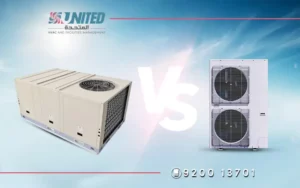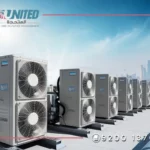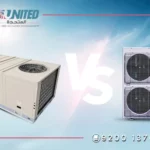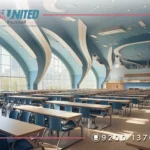10 elements that explain the difference between central air conditioning and hidden air conditioning, and whichever is most suitable for your project.
1- introduction of Central AC and Concealed AC
Central air conditioning works as a single built-in unit that is placed outside the building (on the upper deck or back-bounce, side)
And the” ducting " air ducts are extended from them to the place to be conditioned
The concealed air conditioning console works as a separate outdoor unit that is placed outside the building (on the upper deck or rear, side back)
An indoor unit is installed inside the building above the false ceiling and air ducts are extended from it to the place to be adapted and connected between them with control wires and copper pipes
2- Advantages and disadvantages of central air conditioning
Features central air conditioning With multiple available cooling capacities and the ability to adapt a large area with one air conditioning unit
The "ducted" lengths carry large air ducts and the absence of any maintenance operations inside the building
Permanently renew the air because it contains an air mixing box (Mix Box) and works to mix the return air (Return) with a certain percentage of the outside air.
Central air conditioning is defective It required holes to be made in the concrete to extend the ducting of the air ducts.”
Its high price compared to other systems and the increase in the rate of its electrical consumption
It requires saving a lot of space for the outdoor unit and needs maintenance by a specialized technician
3- Advantages and disadvantages of Concealed air conditioning
Features hidden conditioning With an average price compared to central air conditioning and a low rate of electrical consumption
Its external unit is small in size and does not need holes in concrete, only copper pipes are extended to the walls
Hidden air conditioning defects With limited cooling capacity and the inability to extend air ducts to large lengths
Any malfunction or water leakage in the indoor unit can affect the gypsum ceilings or existing mattresses and require the technician to enter the building
4- Operating conditions and requirements for central air conditioning
Requires central air conditioning Vertical openings in the concrete roof of the building for the passage of air ducts from the central unit to the inside of the building،
Making concrete bases for the outdoor unit, making sure that they withstand the required weight،
External air ducts need special insulation to withstand external temperatures،
Extension of an electricity source next to the unit, the cables of which bear a high electrical load with an operating switch( electric breaker) and all according to the specifications indicated in the manufacturer's catalog
5- Operating conditions and requirements for Concealed air conditioning
Requires Concealed conditioning Pre-poured concrete foundations, either on the roof or internal walls, for both copper pipes and drainage pipes
Also, the installation of control devices (thermostats) on the walls and coordinating their location according to the customer's requirements, taking into account the technical issues of their location،
Extension of an electricity source next to the unit, the cables of which bear a high electrical load with an operating switch( electric breaker) and all according to the specifications indicated in the manufacturer's catalog
6- It is preferably used in:
After clarifying the advantages and disadvantages of each system, how it works and the requirements of its operation, the preference for using one system over the other is clear according to what has been mentioned, for example:
Preferably use Central AC In open spaces with a large area of Common Application in operation such as (school yards, sports clubs, mosques, malls, living halls and councils in palaces or large villas ... etc.)
Preferably use a system Concealed AC In small and separate applications (offices, villas, classrooms ... etc.)
In general, there are no constants in the preference of use, but we are talking about common things where the preference of one system can differ from another according to the customer's requirements
For example, the bedrooms in villas or palaces can be the client's desire that there is no maintenance work inside the rooms for privacy
Here, the central system is used, so before choosing a system, you must know the requirements of each client, the conditions of its location and the appropriate choice for it
7- Cooling capacity
Central air conditioning is characterized by its multiple cooling capacities, starting from 1.5 tons , 2 , 2.5 , 3 , 3.5 , 4 , 5 , 6 , 7.5، 8.5 , 10 , 12.5 , 15 , 17.5 , 20 , 25 , 28 , 30 the availability of the desired capacity varies from brand to brand
Normal concealed conditioning starts from 1.5 tons to 2 , 2.5 , 3 , 3.5 , 4 , 4.5 , 5 the availability of cooling capacity varies from brand to brand
And there is a new system that can fall under the hidden air conditioning system, VRF or VRV
Variable refrigerant flow, Variable refrigerant volume allows a variety of capacities can start from 0.5 tons up to 8.5 tons
8- Electricity consumption
Electricity consumption varies according to the cooling capacity used and also depending on the air conditioning system used
Recently, the inverter technology has appeared, which is a technology that has started to be used in general in electrical appliances
It is a technology that works to gradually increase the electrical load so that a low consumption rate is withdrawn according to the need, gradually increasing until the maximum power is reached, which rationalizes consumption according to the required load
From this point on, air conditioning companies began to compete among themselves to use this technology
In the case of our comparison between Central and hidden air conditioning, the difference comes as the inverter technology began to be used first and largely with the hidden air conditioning system only،
And recently they began to be used with central air conditioning, but not available in all brands
For example Central AC It is characterized by its large electricity consumption due to its high cooling capabilities, its coverage of larger areas, and the lack of significantly available inverter technology
Also the idea of covering more than two different places in the application at the same time negatively affects electricity consumption
For example, the central air conditioner used with a capacity of 10 tons serves a living room with a load of 5 tons, a bedroom of 2 tons, an office of 3 tons and three different applications
That is, during the morning period, we only need to adapt the living room at a rate of 5 tons, and the rest of the load (2 tons bedroom + 3 tons office) will be an unused lost load and then the electrical consumption is greater than the need
Therefore, one of the most important things when using a central air conditioner is to take into account its nutrition for similar places in the application, for example (living room + board + entrance) separately, (swimming pool + games area) etc
So that the maximum amount of available cooling capacity is taken advantage of, and it is preferable not to connect any application with another in case it is possible from a financial and structural point of view
As for the For Concealed adaptation It is characterized by its relatively low consumption compared to Central air conditioning This is for several reasons, including:
Small cooling capacities used،
The ability to feed each vacuum separately،
The presence of inverter technology
There are some factors that can positively affect the overall electricity consumption of the two systems Central and Concealed
- By maintaining the internal temperature By taking into account the non-leakage of cold air outside the cooling space through windows and doors, it is also possible to install air curtains that prevent the exit of cold air or the entry of hot air from the outside, but they are installed more in places where there is a lot of entry and exit traffic, such as Majlis, halls in villas, malls and companies
- By keeping the external heat of the interior unaffected This is done by starting from choosing the direction of the building and not exposing the places of Morning use to the peak of sunlight, and then choosing the thickness of the external walls and the type of insulation used to choose the thickness of the glass and the degrees of insulation used to the types of lighting used
9- The cost
The cost of central air conditioning is significantly higher than hidden air conditioning, starting from the unit price, and then installation work and operating requirements from electrical wiring, concrete bases, external sheet, etc
The cost of any project, whether for central air conditioning or hidden air conditioning, depends mainly on the tables of quantities and specifications or " architectural plans” that show the spaces, division and roles, and then the spaces are raised, the cooling load is studied, the variable air conditioning capabilities are set for each place and role separately, the choice of the air conditioning brand, and finally the project pricing
10- Maintenance
The maintenance of the two systems differs significantly from each other
According to what was explained earlier, all maintenance work for the unit is carried out outside the building or above, which allows the maintenance team to start their work without entering the building and the need to free up enough space by moving some furniture or appliances
As for the hidden air conditioning, its maintenance is inside the building, and at the installation stage, a maintenance hole is made with a size of 60 cm * 60 cm below the indoor unit at the angle of the side where the copper and drain pipes are located, through which any type of maintenance of the indoor unit is performed (checking the Freon pipes, checking the drain pipes, checking the electrical connections, cleaning the filter, etc.)











